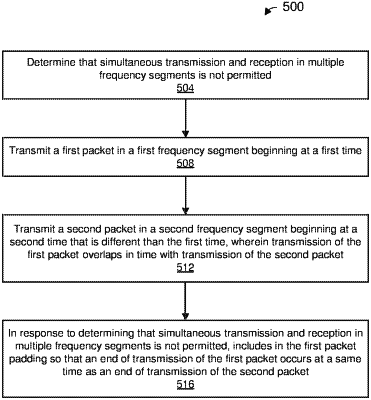| CPC H04L 27/2602 (2013.01) [H04W 72/0453 (2013.01); H04W 72/12 (2013.01); H04W 84/12 (2013.01)] | 20 Claims |

|
1. A method for simultaneously transmitting in multiple frequency segments, comprising:
determining, at a communication device, that simultaneous transmission and reception via multiple frequency segments is not permitted;
transmitting, by the communication device, a first packet in a first frequency segment;
transmitting, by the communication device, a second packet in a second frequency segment;
determining, by the communication device, that an end of the first packet does not align with an end of the second packet;
determining, by the communication device, that at least one of the first packet and the second packet prompts transmission of a respective response packet a defined time period after transmission of the corresponding one of the first packet and the second packet; and
in response to having determined that i) simultaneous transmission and reception via multiple frequency segments is not permitted and ii) at least one of the first packet and the second packet prompts transmission of the respective response packet the defined time period after transmission of the corresponding one of the first packet and the second packet, including, by the communication device, padding in at least one of the first packet and the second packet so that an end of transmission of the first packet is aligned with an end of transmission of the second packet.
|